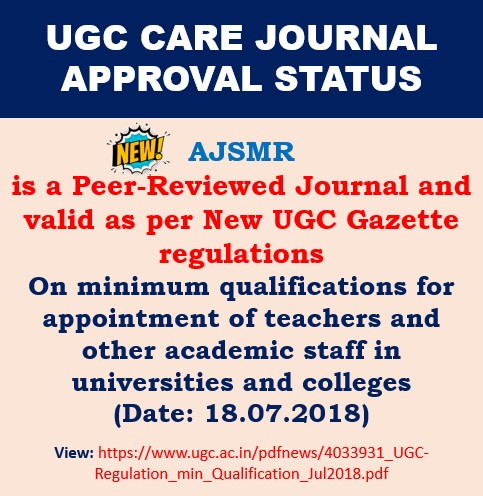Original Research Article I Volume 3 I Issue 4 I 2017
A Study of Total Carbohydrate Modifications induced by Triclosan on Channa punctatus (Bloch)
Ravi Kumar Kola and Prameela Devi Yalavarthy
The American Journal Science and Medical Research; 3(4); 15-18
DOI:http://dx.doi.org/10.17812/ajsmr3404
Abstract:
Triclosan (2,4,4’ –trichloro-2’-hydroxydiphenyl ether)is a chlorinated aromatic compound, used as a synthetic broad-spectrum antimicrobial agent in many personal care products like soaps, hand-washes, toothpastes, mouth washes, deodorants, antiperspirants and shaving creams. The products that contain Triclosan wash down through drains and into water systems and it had become a common contaminant. Triclosan can persist in the environment and exhibit toxicity towards a number of aquatic organisms. Fishes are the most widely distributed organisms and play a central role in aquatic ecosystems. Hence, understanding toxic responses in fish is of high ecological relevance. To assess the aquatic toxicity caused by Triclosan in fresh water fish, Channa punctatus the total carbohydrate modifications were studied. The fishes were exposed to sub lethal and lethal concentrations for 96 hours. Estimation of total carbohydrates in the five tissues-muscles, gill, liver, kidney and brain was done by Carroll et al., method. The total carbohydrate content decreased with the increase of Triclosan concentration. The total carbohydrate levels depletion was observed maximum in Kidney as 36.31% and minimum percentage in brain as 18.93% in sub lethal concentration and maximum in Liver as 42.37% and minimum in Gill as 30.17% in lethal concentrations when compared with the control.The levels of total carbohydrates were found to decrease because of utilization of carbohydrates to meet the energy demands during stress conditions. It was observed that low concentration of Triclosan (0.37 ppm) is also very toxic and causes alterations in vital organs of fish, Channa punctatus
Keywords:
Triclosan, aquatic toxicity, Channa punctatus, carbohydrates
References:
[1]. Affonso, E.G., Polez, V.L.P., Correa ,C.F., Mazon, A.F., Araujo, M.R.R., Moraes, G., and Rantin, F.T.,2002. Blood parameters and metabolites in the teleost fish Colossoma macropomum exposed to sulfide or hypoxia. Comparative Biochemistry and Physiology Part C 2002; 133:375-382.
[2]. Agrahari, S., Pandey, K.C. and Gopal, K. 2007. Biochemical alteration induced by monocrotophos in the blood of fish, Channa punctatus (Bloch). Pesticide Biochemistry and Physiology, 88: 268-272.
[3]. Agrahari, S., and Gopal, K.,2009. Fluctuations of certain biochemical constituents and markers enzymes as consequence of monocrotophos toxicity in the edible freshwater fish, Channa punctatus. Pesticide Biochemistry and Physiology, 94, 2009, 5-9.
[4]. American Medical Association 2000. Use of Antimicrobials in Consumer Products. Report 2 of the Council on Scientific Affairs (A-00).
[5]. Carrol, N. V., Longley, R. W. and Roe, J. H., 1956. Glycogen determination in liver and muscle by use of anthrone reagent. J. Biol. Chem. 220: 583-593.
[6]. Daughton, C., and Ternes, T.A,1999. Pharmaceuticals and personal care products in the environment: agents of subtle change. Environmental Health Perspectives 107 907-937.
[7]. Dutta, H.M., and Dalal, R.,2008. The effect of endosulfan on the ovary of bluegill sunfish: a histopathological study (Lepomis macrochirus sp). International Journal of Environmental Research 2008; 2:215-224.
[8]. Environmental Working Group (EWG), 2008. Pesticide in Soap, Toothpaste and Breast Milk—Is It Kid-Safe? Washington, DC: Environmental Working Group; 2008.
[9]. Finney D.J. 1971 Probit analysis: a statistical treatment of the sigmoid response curve. Cambridge: Cambridge University Press, 256 p.
[10]. Gautam, K., and Gautam, R.K., 2001.Diazinon and Endosulfan showed marked decrease in basic proteins in gastrointestinal tract of Channa punctatus. J N Conser 2001; 12(2): 181-184.....
Article Dates:
Received: 23 October 2017; Accepted: 28 November 2017; Published: 31 December 2017
How To Cite:
http://dx.doi.org/10.17812/ajsmr3404 Received :23 October, 2017 Accepted; 28 November, 2017 Available online :31st December, 2017



